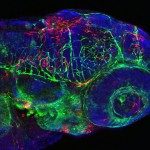Link to Pubmed [PMID] – 21653665
J. Virol. 2011 Aug;85(16):8181-7
Interferons (IFNs) play a major role in orchestrating the innate immune response toward viruses in vertebrates, and their defining characteristic is their ability to induce an antiviral state in responsive cells. Interferons have been reported in a multitude of species, from bony fish to mammals. However, our current knowledge about the molecular function of fish IFNs as well as their evolutionary relationship to tetrapod IFNs is limited. Here we establish the three-dimensional (3D) structure of zebrafish IFNϕ1 and IFNϕ2 by crystallography. These high-resolution structures offer the first structural insight into fish cytokines. Tetrapods possess two types of IFNs that play an immediate antiviral role: type I IFNs (e.g., alpha interferon [IFN-α] and beta interferon [IFN-β]) and type III IFNs (lambda interferon [IFN-λ]), and each type is characterized by its specific receptor usage. Similarly, two groups of antiviral IFNs with distinct receptors exist in fish, including zebrafish. IFNϕ1 and IFNϕ2 represent group I and group II IFNs, respectively. Nevertheless, both structures reported here reveal a characteristic type I IFN architecture with a straight F helix, as opposed to the remaining class II cytokines, including IFN-λ, where helix F contains a characteristic bend. Phylogenetic trees derived from structure-guided multiple alignments confirmed that both groups of fish IFNs are evolutionarily closer to type I than to type III tetrapod IFNs. Thus, these fish IFNs belong to the type I IFN family. Our results also imply that a dual antiviral IFN system has arisen twice during vertebrate evolution.

